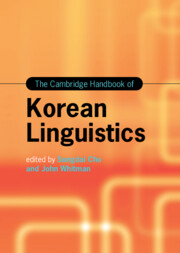Book contents
- The Cambridge Handbook of Korean Linguistics
- Cambridge Handbooks in Language and Linguistics
- The Cambridge Handbook of Korean Linguistics
- Copyright page
- Contents
- Figures
- Tables
- Contributors
- Preface
- Acknowledgments
- Abbreviations
- Part I Korean Overview
- Part II Phonetics and Phonology
- Part III Morphology and Syntax
- Part IV Semantics and Pragmatics
- Part V Sociolinguistics and Psycholinguistics
- Part VI Language Pedagogy
- Chapter 26 The Genre-Based Approach to Korean Language Teaching: A Curriculum Application
- Chapter 27 Towards Integrated Performance Assessment
- Chapter 28 Interactional Competence in the Korean Language
- Chapter 29 From Bilingual Speakers to Korean Heritage Language Learners
- Chapter 30 Language Policy and Its Effect in South Korea
- Index
- References
Chapter 29 - From Bilingual Speakers to Korean Heritage Language Learners
from Part VI - Language Pedagogy
Published online by Cambridge University Press: 30 September 2022
- The Cambridge Handbook of Korean Linguistics
- Cambridge Handbooks in Language and Linguistics
- The Cambridge Handbook of Korean Linguistics
- Copyright page
- Contents
- Figures
- Tables
- Contributors
- Preface
- Acknowledgments
- Abbreviations
- Part I Korean Overview
- Part II Phonetics and Phonology
- Part III Morphology and Syntax
- Part IV Semantics and Pragmatics
- Part V Sociolinguistics and Psycholinguistics
- Part VI Language Pedagogy
- Chapter 26 The Genre-Based Approach to Korean Language Teaching: A Curriculum Application
- Chapter 27 Towards Integrated Performance Assessment
- Chapter 28 Interactional Competence in the Korean Language
- Chapter 29 From Bilingual Speakers to Korean Heritage Language Learners
- Chapter 30 Language Policy and Its Effect in South Korea
- Index
- References
Summary
Chapter 29 examines the recurring attributes in current definitions of HL learners. These include early and significant exposure to the HL, proficiency in the HL, bilingualism to some degree, dominance in a language other than the HL, and an ethnic/cultural connection to the HL. From sociolinguistic journey, Korean heritage language (KHL) learners often end up with high receptive language skill, low to moderate accuracy in their speaking, and zero metalinguistic knowledge, and consequently enroll in Korean language in college to (re)learn their HL language. This poses pedagogical challenges, as KHL learners are linguistically distinguished from L2 learners due to their language experience. This chapter explores issues in language acquisition, language attrition, and language processing of Korean-English bilingual children and how such experience sheds light in understanding the pedagogical issues related to the language processing of young adult KHL learners.
Keywords
- Type
- Chapter
- Information
- The Cambridge Handbook of Korean Linguistics , pp. 832 - 848Publisher: Cambridge University PressPrint publication year: 2022



